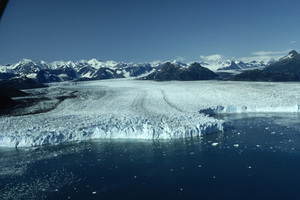As ice sheets melt, they can release pent-up energy and trigger massive earthquakes, according to new study.
Global warming may already be triggering such earthquakes and may cause more in the future as ice continues to melt worldwide, the researchers say.
A series of large earthquakes shook Scandinavia around 10,000 years ago, along faults that are now quiet, the scientists point out.
The timing of each earthquake roughly coincided with the melting of thick ice sheets from the last ice age in those same places.

|
| ©Joe Scherschel/NGS
|
Alaska's Columbia Glacier has been retreating in recent years.
A new study has found that melting ice sheets can release pent-up energy and trigger massive earthquakes. A separate, earlier study found that small earthquakes were more common in Alaska in the summers, when ice there was melting.
|
Researchers had suspected that the melting had triggered these earthquakes by releasing pressure that had built up in Earth's crust.
Now a new study, the first to use sophisticated computer models to simulate how ice sheets would affect the crust in the region, bolsters this scenario.
The study showed that earthquakes are "suppressed in presence of the ice and promoted during melting of the ice," said study leader Andrea Hampel of the Ruhr University Bochum in Germany.
Hampel and a colleague had earlier found evidence that the shrinkage of a huge lake at the end of the last ice age had triggered a series of large earthquakes in Utah.
The new study shows this can happen even along faults that are normally quiet and are not prone to slip.
The new research will be published soon in the journal Earth and Planetary Science Letters.
Ancient Quakes Rocked ScandinaviaThe ancient earthquakes marched northward through Scandinavia as ice sheets retreated.
They began in the south of what is now Sweden about 12,000 years ago, then hit south-central Sweden near modern-day Stockholm around 10,500 years ago.
Finally the earthquakes hit Lapland, in northern Scandinavia, about 9,000 years ago.
Based on the amount that the faults slipped, it seems these ancient earthquakes were massive, registering about magnitude 8 - bigger than the quake that devastated Kashmir in 2005.
Today those Scandinavian faults rarely cause quakes, and when they do, the temblors are small, usually less than magnitude 5.
"With our new modeling technique we can model faults themselves and directly compare the slip on the model fault to the slip on natural faults," Hampel said.
The models showed that thick ice could weigh down the land, preventing a fault from slipping and thereby causing it to store up that energy.
The thicker the simulated ice sheets - from 325 to 6,500 feet (100 to 2,000 meters) thick - the more they suppressed earthquakes, and the bigger the earthquakes were after the ice sheets melted.
Since the amount of movement on the fault in the model matched the actual amount of slippage measured in the field, this supports the idea that the melting of ice sheets had triggered the earthquakes, Hampel said.
Global Warming Causing Quakes?Such melt-induced earthquakes are not just a thing of the past and could be happening today, since global warming is melting ice worldwide, the team says.
"The frequency of earthquakes should increase in the future if the ice continues to melt," Hampel and colleagues write in their study.
"The current low level of seismicity in Greenland and Antarctica may be caused by the presence of the large ice sheets."
Jeanne Sauber of NASA's Goddard Space Flight Center in Greenbelt, Maryland, has led research showing a recent increase in earthquakes in Alaska when the ice was melting the most.
"All of sudden, between 2002 and 2006, we had warmer temperatures and much more rapid ice wastage," Sauber said.
Even though ice thickness shrank 10 percent or less, this was apparently enough to trigger small earthquakes in the summers when the ice was melting, the study showed.
"It's harder to see if there's an influence on large earthquakes, because they don't happen as often," Sauber added.
"We expect that in Greenland and Antarctica, if they start rapidly losing lots of ice, you would expect at least some little earthquakes."
Reader Comments
to our Newsletter